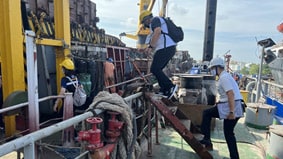At a glance
CDC’s Asia Field Program in the Division of Global Migration Health (DGMH-Asia) works with government partners and nongovernmental organizations in the region to prevent infectious diseases at border crossings and in mobile populations such as refugees, immigrants, and migrants.

CDC's Impact in Southeast Asia
DGMH-Asia works with partners in Southeast Asia to improve the health of U.S.-bound refugees and immigrants and prevent the spread of infectious diseases through:
- DGMH-Asia supported and funded a World Health Organization (WHO) course on Ship Sanitation Inspection and Issuance of Ship Sanitation Certificates in Thailand, which included a 2-day training session on a training vessel named "Sakhon Wisai" of the Marine Department. Site visits and training for panel physicians performing resettlement medical exams of refugees and immigrants—detecting and treating deadly diseases like tuberculosis
- Promoting preventive treatments for refugees, focusing on parasitic diseases, anemia, and chronic Hepatitis B
- Promoting vaccination of refugees and immigrants for diseases such as COVID-19, polio, measles, and diphtheria before departure
- Providing technical assistance and training to officials working within the region at international border crossings that allows them to better detect, treat, and track diseases that threaten the health of refugees, immigrants, travelers, and destination communities.
- Supporting disease surveillance and vaccination programs in refugee camps on the Thai-Burma border
- Supporting Thai Ministry of Public Health (MPOH) and Laos Ministry of Health projects in migrant health, border health, and travel medicine

To prevent the spread of infectious diseases among international travelers, immigrants, refugees, and other mobile populations, DGMH-Asia is at the forefront of addressing public health threats locally before they cross international borders.
Note
Immigrant and Refugee Health
Thousands of refugees and immigrants from Southeast Asia migrate to the United States each year. DGMH-Asia ensures that health examinations of immigrants and refugees throughout the region follow CDC's regulatory requirements for detecting and preventing the importation of communicable diseases like tuberculosis. DGMH-Asia also supports disease surveillance and outbreak response in refugee camps along the Thai-Myanmar border.

Additionally, DGMH-Asia provides technical assistance to Thailand's MPOH, Laos Ministry of Health (MOH), the International Rescue Committee, Malteser International, International Organization for Migration, International Federation of Red Cross, and other partners to stop the spread of infectious diseases among travelers and mobile populations crossing international borders.
Furthermore, Thailand has more than 2 million migrant workers, who travel from other countries in the region to work. The DGMH-Asia team also works to describe, quantify, and visualize mobility patterns of farmworkers in Thailand and the surrounding region in collaboration with Thai MPOH and IOM, describing demographic characteristics, health risks, and barriers to accessing healthcare.
Top Countries in Southeast Asia Hosting Immigrants, mid-year 2020
1. Bangladesh
2. China
3. India
4. Philippines
5. Vietnam
Source: UN DESA, 2020
Top Countries in Southeast Asia Processing Refugees, FY 2021
1. Malaysia
2. Thailand
3. Indonesia
4. Philippines
5. Cambodia
Global Health Security
DGMH-Asia's efforts strengthen countries' abilities to prevent, detect, and respond to infectious disease outbreaks before they become global epidemics by working with local, regional, and global organizations to support disease outbreak response, surveillance, laboratory systems, and workforce development at the local and regional levels. These efforts aim to help countries in Southeast Asia reach the targets outlined in the Global Health Security Agenda (GHSA), a global partnership to make the world safer and more secure.
The team also works with Thai and Laos health officials to support the development of training, response exercises, and emergency response plans for the international border crossings. Multisector and cross-border collaborations are also emphasized to ensure information is shared quickly in times of disease outbreaks and population fluxes.
Note
COVID-19 Response
DGMH-Asia supported the COVID-19 response in the region through several initiatives:
- Financially and technically supported COVID-19 testing and outbreak response efforts in refugee camps. Held regular calls with healthcare providers to monitor progress, share information, and coordinate efforts.
- Supported tracking of vaccine coverage, vaccination records management and certification systems, and projects to build demand for COVID-19 vaccines for refugees and migrant workers throughout Thailand.
- Recruited migrant volunteers from Bangkok and Phuket to train them on COVID-19 detection and prevention.
- Developed the regional border health initiative with the International Organization for Migration providing training for immigration officials, assessments of international Points of Entry, and population mobility monitoring along the Thai-Laos and Thai-Cambodia borders.
- Supported Thailand's MPOH development of an electronic COVID-19 vaccine registry for international travel. The system produces a COVID-19 vaccine certificate accessible via a smartphone application "MorPhrom" with scannable QR codes that are compatible with systems in Singapore and the European Union.
Note
Provided technical support and funding for the COVID-19 testing of more than 20,000 specimens and facilitated the detection of 20 COVID-19 outbreaks.
During July 2021 to June 2022, the electronic COVID-19 vaccine registry system generated more than 250,000 electronic certificates issued via the "MorPhrom" phone app.
